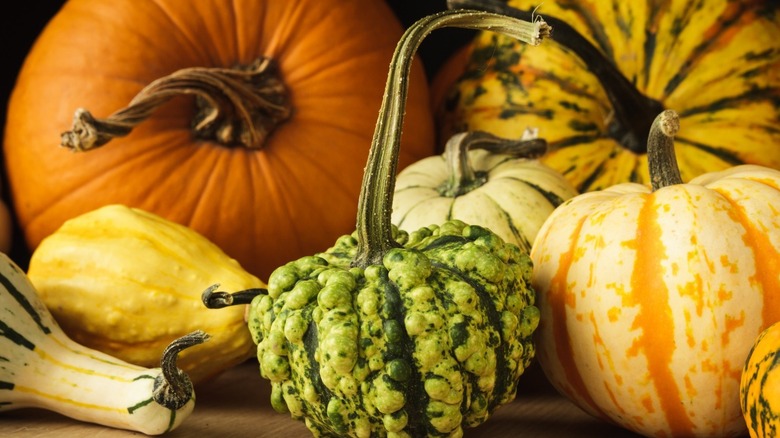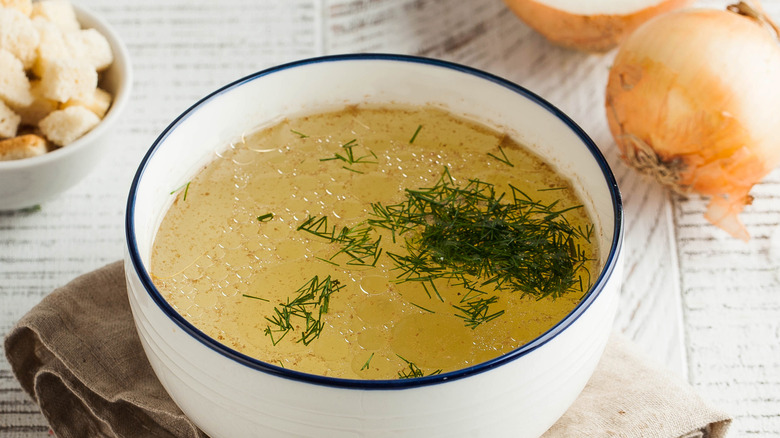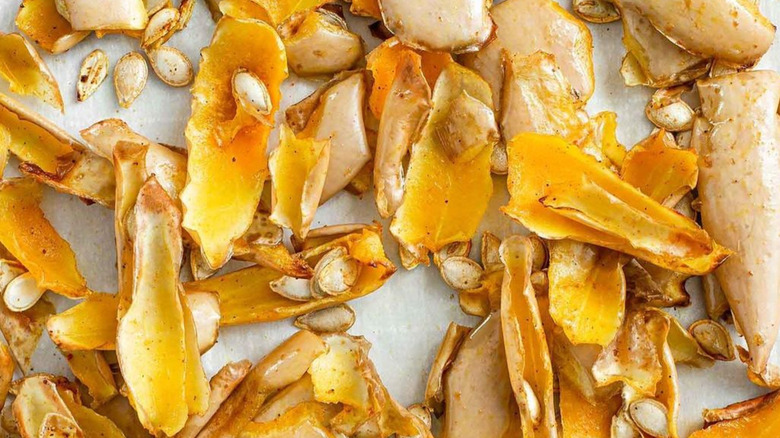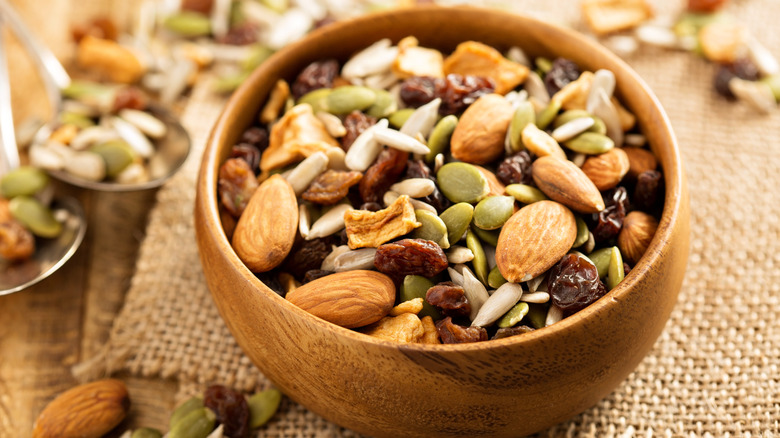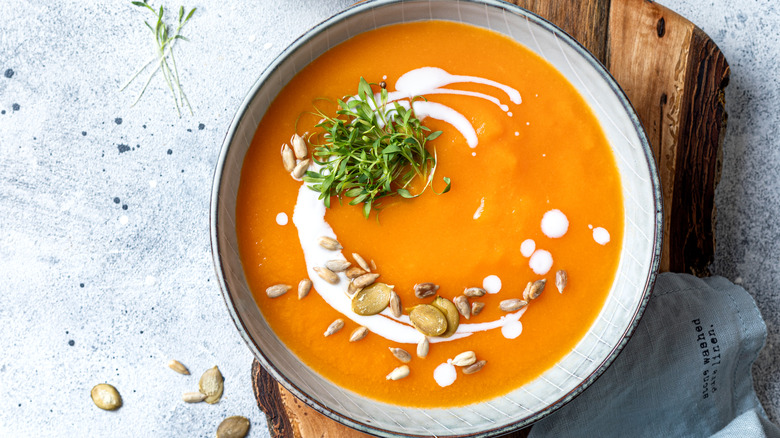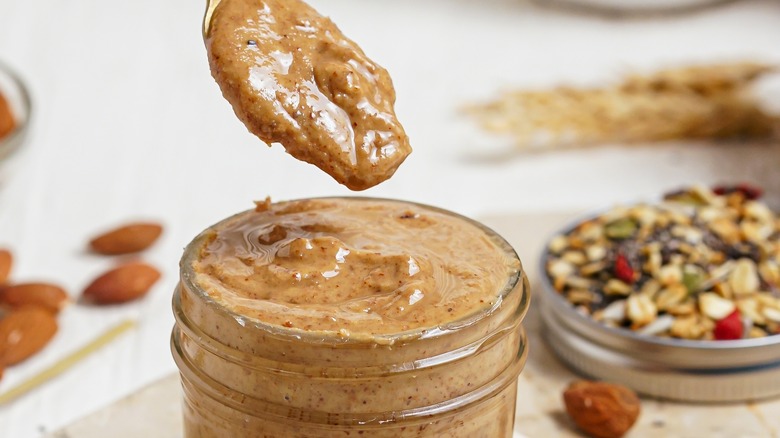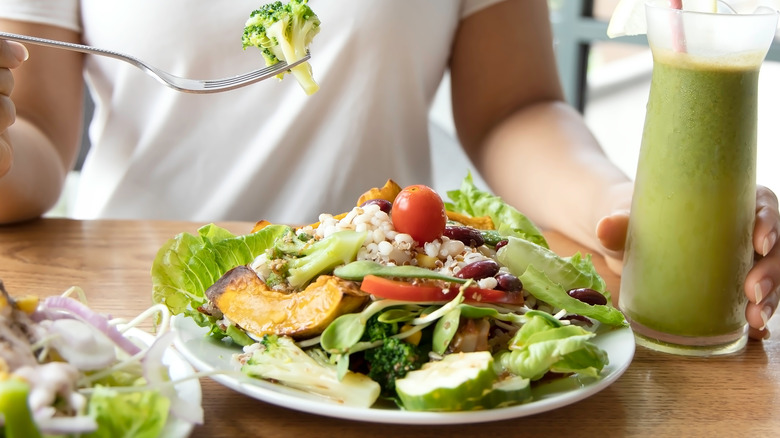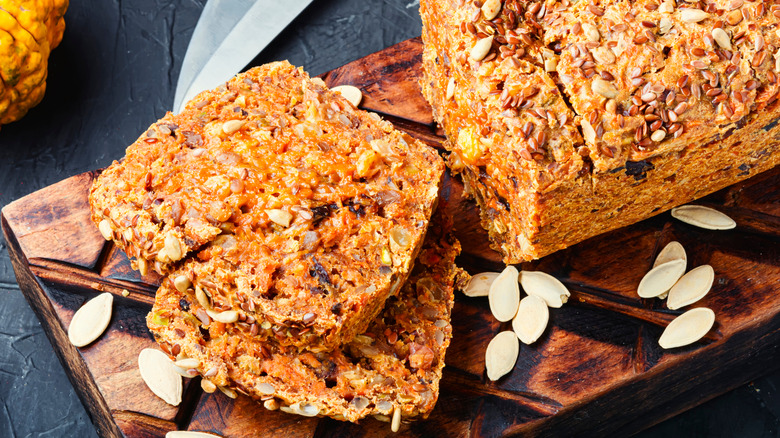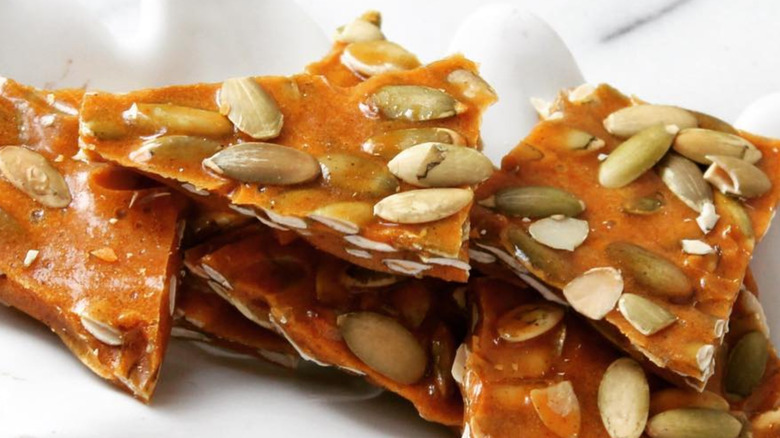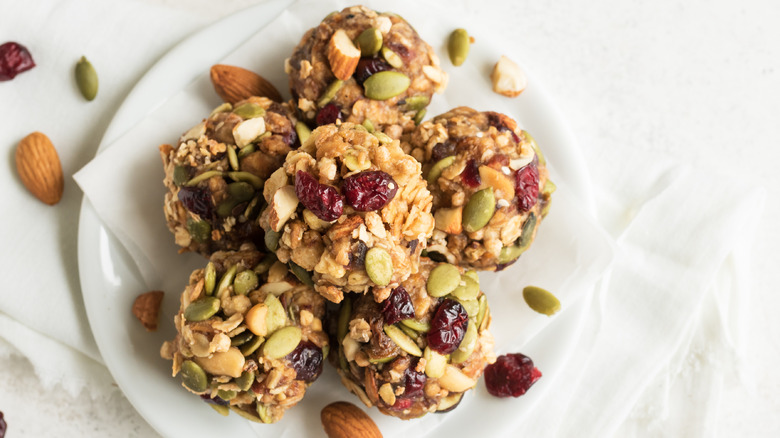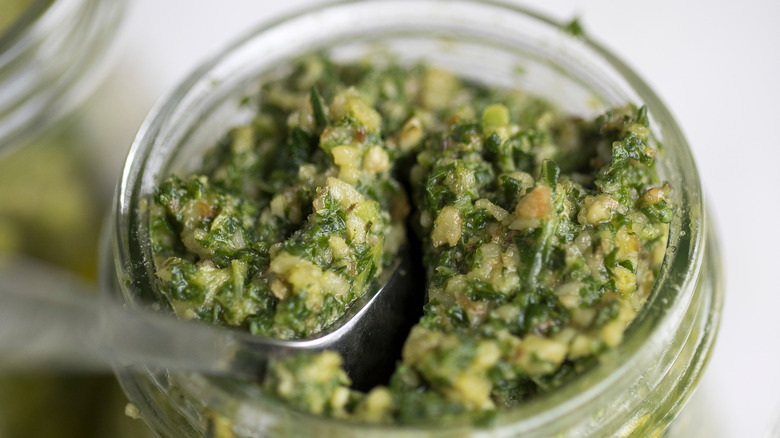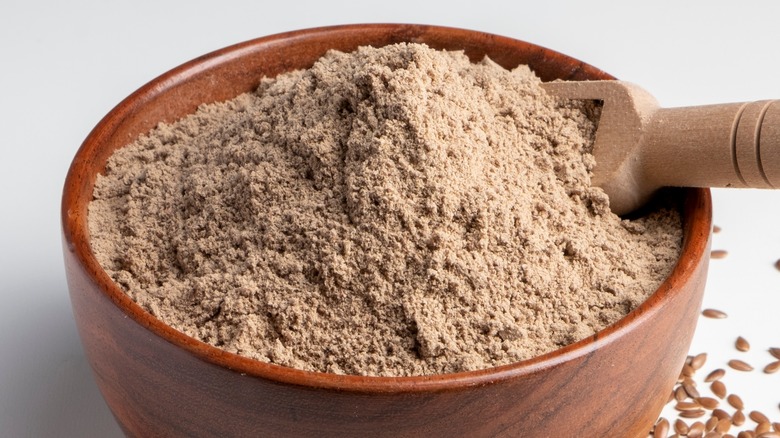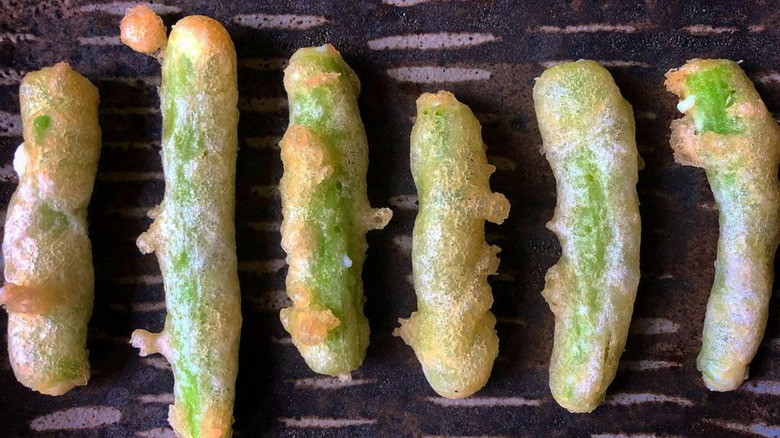The Best Ways To Use Squash Peels And Seeds
After you've made a recipe involving squash, don't throw away those scraps! There are a surprising number of ways you can use them in your cooking, and several reasons why you should: to reduce food waste, to make the money you spend on food stretch even farther, and to expand your culinary creativity with new techniques.
It may come as a surprise, but according to Well And Good, all parts of a squash are edible. Of course, most people have eaten the flesh inside of a squash, and many know that squash blossoms are a type of edible flower – but it turns out that the skin and seeds of these vegetables can also be eaten. Britannica shares that the squash members of the Cucurbitaceae family include summer squashes like zucchini and pattypan, and winter squashes like butternut, spaghetti squash, and even pumpkin. It's not difficult to find recipes for pumpkin seeds (or pepitas), and now you'll have even more options by using seeds from your other squashes. There are delicious ways to use the peels from your squash, and believe it or not, there's even a suggestion for cooking with squash stems.
1. Flavor stock
One of the most popular pieces of advice in the culinary world is to save all the odds and ends from vegetables, herbs, and meats to make homemade stock. This also goes for the peelings from squash, according to The Kitchn. The trimmings from just one squash won't be enough for a pot of stock, however, so a great strategy is to collect vegetable scraps like squash throughout the week and store them in a bag in your fridge or freezer. (Make sure they're washed and chopped before storing.) About four cups of veggie scraps is enough to make a big batch of homemade stock, either as a base for chicken or beef stock or to make a flavorful vegetable stock.
2. Make squash peel chips
Many cooking methods for squash call for the peels to be removed and discarded, but for this idea, the squash peels are the star of the show. Food blog Tasty Thrifty Timely shares that when chopped into small pieces and tossed with oil, peels from winter squashes like butternut transform into crispy and tasty "chips." Squash chips can be seasoned simply with a little salt and pepper, or add a flavorful spice blend from your favorite cuisine like curry powder, za'atar, or a spicy Cajun seasoning blend.
Eat the squash chips as a snack or sprinkle them over soups and salads for an extra dose of crunch. British chef Max La Manna shares on his website that he likes to pair the crispy roasted peels with toasted squash seeds; he uses the combination to garnish a savory pasta dish made with garlic and roasted sage.
3. Add seeds to trail mix
It's easy to roast squash seeds and transform them into a delicious snack. The View From The Great Island shares that it only takes a little oil, some seasoning, and a short time in the oven to roast seeds from a winter squash, just as you would when roasting pumpkin seeds.
Once your seeds are roasted and cooled, Food52 suggests adding them to your favorite trail mix — either to a homemade blend or to jazz up a store-bought version. Also known as G.O.R.P (good old raisins and peanuts) trail mix can be any combination of nuts, seeds, dried fruits, candies, and chocolate chips. Roasted squash seeds give the mix a salty touch and some added crunch.
4. Make soup
Pumpkins are in the same family as winter squashes like butternut and delicata, and just like pumpkins, the seeds from these squashes can be roasted and eaten. In addition to sprinkling squash seeds on top of soup, they can be used to actually create it! In this soup recipe from Better Homes & Gardens, roasted pumpkin seeds are soaked overnight in stock, and then blended down in a food processor with white beans and sauteed peppers and onions to make a creamy soup base.
You can use 100% roasted squash seeds in recipes like this, or use a combination of these and pumpkin seeds. For even more squashy goodness, make your soup using stock that you flavored with squash peels, or add cooked cubes of butternut or acorn squash to the soup.
5. Make seed butter
Seed butters can be a delicious alternative to nut butters, and will surely add some variety to the spreads in your pantry. Tahini is a seed butter made from ground sesame seeds, and sunflower seeds can be ground to a peanut butter-like consistency to make sunbutter. You can make a similar spread using your roasted squash seeds, according to FoodPrint. You'll want to remove the hulls first, which can easily be done by first cracking the seeds under a rolling pin and then briefly boiling them so that the shells slip off. Use a food processor to grind the seeds into a smooth and spreadable butter, then add ingredients like cinnamon or other spices for flavor, plus oil and sweeteners like honey.
6. Add seeds to salads
Once squash seeds are drizzled with oil and toasted, they become crunchy and flavorful — especially when you add in your favorite spices. These toasted seeds are delicious sprinkled over salads, according to Food52, who says a garnish of squash seeds make a salad "taste like fall." They also recommend toasting the squash seeds with the same seasonings you use to make your favorite homemade dressing for a topping that's especially delicious on a green salad or grain bowl. Another way to incorporate squash into your salad? If you roast the peels to make squash peel chips, break them into small pieces to scatter over your salad for even more crunch and a bit of saltiness.
7. Add seeds to breads
Another way to use your shelled and roasted squash seeds is to incorporate them into your homemade bread, as FoodPrint suggests. The squash seeds add texture and crunch to your bread; plus, you can season the seeds before they go into the oven to make them even more well-suited to the flavor of your loaf. Think cinnamon-spiced seeds for banana bread, or a healthy coating of za'atar blend for seeds going into savory loaves.
Try this recipe from With Food And Love for a bread made entirely from seeds, which is perfect when you're looking for a vegan bread option, or need something for your loved one who eat keto or gluten-free diets. You can use squash seeds in place of — or in addition to — the pumpkin, flax, and chia seeds used to create this loaf.
Use your roasted squash seeds in other treats too, like pancakes, waffles, granola bars, or cookies.
8. Make candy
Most of these suggestions for ways to use squash seeds and peels are savory and fairly healthy, like toppings for salads, homemade stock, and bread. To change things up, here's a treat that's pure sugar! Foodprint suggests stirring hulled, roasted squash seeds into a batch of brittle. This crunchy candy is often made with peanuts, but with its base of cooked sugar and butter it's also delicious when made with squash seeds.
Let these seeds shine on their own in the cooled and broken up pieces of brittle, or combine them with other seeds or chopped nuts. Martha Stewart's recipe uses just four ingredients, including pumpkin seeds, which you can swap out for squash seeds.
According to FoodPrint, squash seeds can also be used in other sweets, like chocolate candies or a simple chocolate bark.
9. Make energy balls
Strike a balance between sweet and healthy by adding squash seeds to your favorite healthy, homemade snacks like energy balls. Remove the hulls from the seeds by boiling them for a short time, which makes them slip off easily. Then, roast your seeds to make them crispy and bring out their flavors. Once that's done, simply fold them in with the rest of your energy ball ingredients! Pinch Of Yum likes to use a combination of oats, almond butter, chocolate chips, and maple syrup in their recipe.
Nutrition-wise, The Spruce Eats notes that squash seeds aren't too shabby. A cup of seeds has 12 grams of protein, 12 grams of fiber, and respectable amount of nutrients like magnesium, iron, and calcium.
10. Add seeds to pesto
A classic pesto of basil, garlic, and pine nuts is irresistible. But according to Brit & Co., it's easy to make intriguing variations, like swapping out the basil for arugula or beets. Even the pine nuts can be changed out — use roasted, seasoned winter squash seeds in your pesto to create a nutty flavor along with other flavorings like garlic and lemon juice. Food52 says that squash seeds give pesto a distinctly fall-like flavor and can totally replace (or be combined with) pine nuts in your recipe.
In this recipe from Whole Foods Market, pumpkin seeds are blended with a generous amount of cilantro to make a pesto that's good for more than just pasta: Try it with roasted veggies as a filling for sandwiches.
11. Turn seeds into flour
Here's an excellent suggestion for the seeds left over from preparing your butternut, acorn, or other squashes: Grind them into a flavorful flour. Food & Wine says this is easy to do as long as you have a powerful food processor or clean coffee grinder. First, rinse the seeds well to remove the stringy bits of squash and other residue, then dry them out thoroughly in an oven at low heat. You won't use any oil or seasonings — this step is just to remove all the moisture. Once the seeds are cool, pour them into the food processor or grinder, and process them into a fine flour.
Store this flour in a sealed container in the fridge, and use it as you would other alternative flours in your baked goods and recipes.
12. Stuff and fry the stems
Now that you have all these great ideas for putting your squash seeds and peels to good use, don't forget that you can eat the squash stems, too! (When Well + Good says that all parts of the squash are edible, they mean it!) Row 7 Seeds has one recipe idea, where stems from tetra squash (a type of delicata) are cleaned, blanched, then tossed with a cacio e pepe-inspired sauce made of vegetable stock and Parmesan. And in an Instagram post, North Carolina chef Brian Canipelli shared some squash stems that he stuffed with ricotta cheese, then battered and deep-fried.
The squash stems shared by both Row 7 Seeds and Chef Canipelli are thin, green, and undoubtedly tender before they ever hit a hot pan — it's doubtful that the thick, craggy stems of, say, a large pumpkin would ever be tender enough to bite into. So when saving your squash stems to eat, choose those that are still green and pliable, and need only a brief cooking period to be ready to eat.
